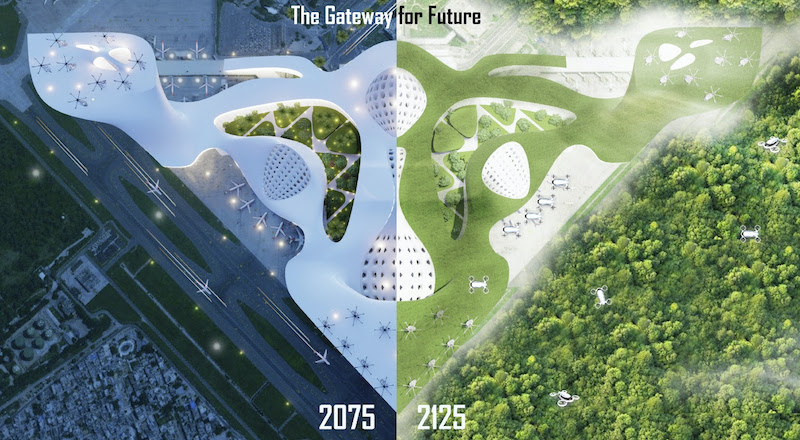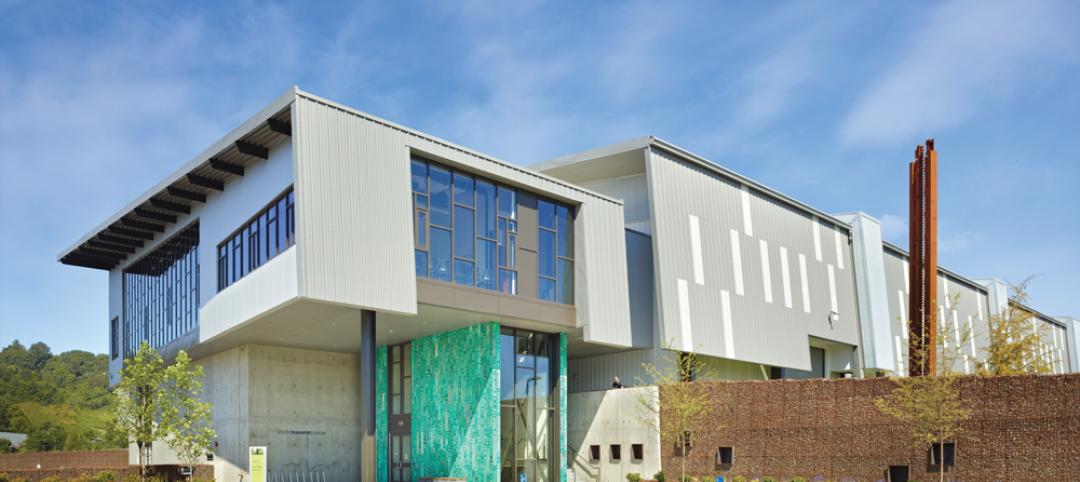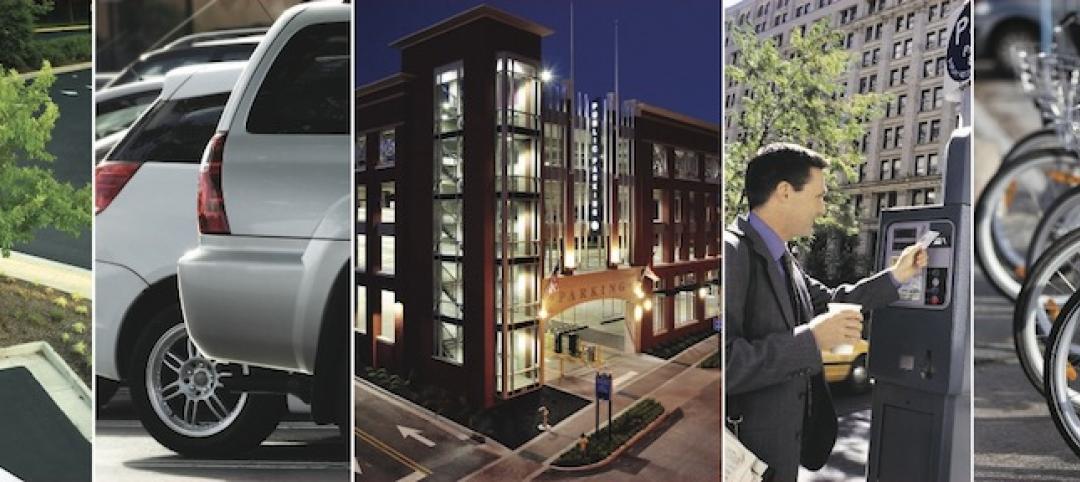The Green Gateway—a zero-emission, highly sustainable multimodal hub—has been named the winner for the 2020 Fentress Global Challenge (FGC), an annual global student design competition launched in 2011 by Fentress Architects that represents the firm’s commitment to advancing innovative design in public architecture and attracts students from around the world.
Envisioning the Airport of the Future
With over 100 submissions from students in over 15 countries, this year’s competition challenged participants to envision airport mobility in the year 2100. Participants proposed a diverse spectrum of design concepts to improve the airport passenger terminal building, addressing the key factors such as futuristic transportation technologies, urbanization, globalization, technology, flexibility, security, project feasibility, and passenger experience.
The 2020 winning proposals reflect the radical innovation, quality and curiosity required to advance airport terminal design. The first-place prize is valued at USD$15,000, second place USD$3,000, third place USD$2,000, and the two People’s Choice Awards will receive USD$1,000.
“A deep passion for design and a creative mindset are the cornerstone of any successful design competition submission,” said Curtis Fentress, FAIA, RIBA, Principal in Charge of Design at Fentress Architects. “Each year, the submissions we receive are more innovative, spirited and dynamic than the prior year, which shows an exciting outlook for the future of terminal design. We’re greatly impressed by this year’s winners and every submission we received.”
 First-Place Winner: BANIYA, The Green Gateway, designed by Nikhil Bang and Kaushal Tatiya from the Southern California Institute of Architecture.
First-Place Winner: BANIYA, The Green Gateway, designed by Nikhil Bang and Kaushal Tatiya from the Southern California Institute of Architecture.
A Green Gateway
The winning concept, designed by Nikhil Bang and Kaushal Tatiya from the Southern California Institute of Architecture (SCI-Arc), transforms Indira Gandhi International Airport into a forward-thinking, sustainable multimodal hub that mitigates the enivironmental impacts of air travel while enhancing mobility across New Delhi, India—one of the most populated and polluted cities in the world. The design, dubbed “the Green Gateway,” proposes a future where airports are more than buildings; they provide a seamless connection to the cultural context of the site, from their planning to their form and materiality.
Embracing sustainable design strategies, the zero-emission concept features a decentralized system of one central terminal and six towers dispersed throughout the city. The towers provide a dual purpose, working as both air-purifying centers and stations for flying cars. This solution significantly improves mobility across the city by replacing domestic flights as one of the major sources of pollution.
The students’ submission describes the airport’s design as “zero-emission at the macro and micro level, improving mobility across the city by replacing domestic flight as one of the major sources of pollution and making air travel a personal affair.”
Second Place Winner
Second-Place Winner: Sejkul, Hartsfield-Jackson Atlanta International Drive-In Airport by Dušan Sekulic, University of Ljubljana, Slovenia.
What does travel and transportation look like in 2100? According to second-place winner Dušan Sekulic—a student at the University of Ljubljana, Slovenia—fully autonomous pods, driving chairs, AI-powered navigation, and vertical take-off and landing (VTOL) aircraft will be key ingredients to designing the next-gen airport experience. The concept proposes reimagining Hartsfield-Jackson Atlanta International Airport (ATL)—the busiest airport in the world—as a drive-in airport where travelers’ individual pods and driving chairs bring them directly to the aircraft. Playing off of Atlanta’s reputation as a “city in the forest,” the new ATL will feature a green design approach, merging the airport with the city’s skyline to create an “airport in the forest.”

Autonomous pods move passengers throughout the futuristic terminal. Second-Place Winner: Sejkul, Hartsfield-Jackson Atlanta International Drive-In Airport by Dušan Sekulic, University of Ljubljana, Slovenia.
Third Place Winner

Third-Place Winner: W.A.D, Floating Aero City designed by Yuanxiang Chan, Chaofan Zhang, and Zhuangzhuang King from Beijing Jiaotong University.
This year’s third-place winner responded to an ever-important reality: how airport design can prepare airports located in high density seaside cities to adapt to the effects of climate change. Floating Aero City, designed by Yuanxiang Chan, Chaofan Zhang, and Zhuangzhuang King from Beijing Jiaotong University, provides a highly visionary approach to sustainable design. Located in Hong Kong, the airport responds to the site’s subtropical climate conditions and high density issues. Floating on Hong Kong’s ocean, the airport’s three-dimensional, moveable platform reduces the impact on the natural terrain while increasing available land. The structure’s vertical form significantly reduces the time it takes passengers to flow from check-in to boarding, enhancing the overall passenger experience. Sustainable design strategies include daylighting, tidal power generation, a circular runway and hydrogen-powered aircraft.
People’s Choice Awards

#1 People’s Choice Award Winner: Arch YiYang, The Vertebrae, designed by Yi Yang Chai and Sharon Cho from the University of Malaya.
The Vertebrae, designed by Yi Yang Chai and Sharon Cho from the University of Malaya, won the #1 People’s Choice Award with more than 6,200 public votes. The biophilic design harmonizes the built environment with nature to create a “garden city”—the future airport archetype that forms a contextual representation of its culture. Located in Singapore, the concept infuses a biophilic and sustainable approach into every element of the design to renvision the airport as a model of sustainability while amplifying the country’s national identity.
“This is a beautiful concept with a strong connection to existing structures and attention to the environment,” said Lois Kramer, a 2020 FGC Juror and CEO at KRAMER aerotek inc. “The design is resilient in how it addresses air pollution and possibility of evolving modes of transportation."

#2 People’s Choice Award Winner: RIE, O’Pon the Hill, designed by Ridwan Arifin, Imaduddin Dhia Ul-Fath and Ervin Dwiratno from Yogyakarta University of Technology
Garnering over 5,900 public votes, O’Pon the Hill Airport landed the #2 People’s Choice Award. Designed by Ridwan Arifin, Imaduddin Dhia Ul-Fath and Ervin Dwiratno from Yogyakarta University of Technology, the concept blends culture, history and technology to envision the future of O’Hare International Airport. This futuristic terminal features a Smart Air Pad to accommodate vertical take-off and landing. Equipped with nanotechnology, the Smart Air Pad examines the performance of aircraft. Additionally, People Mover Pods move passengers throughout the terminal, enhancing circulation and the overall passenger experience.
2020 Fentress Global Challenge Jurors
This year’s winners were handpicked by seven esteemed jurors that are experts in aviation, architecture and engineering.
Jury members include:
- Curtis W. Fentress, FAIA, RIBA – Principal in Charge of Design, Fentress Architects
- Agatha Kessler – Chairman, Fentress Architects
- Lois Kramer – CEO, KRAMER aerotek inc.
- George Miller – COO, Richard Meier & Partners Architects LLP
- Dr. Patricia A. Ryan – President, Decision Services International
- Somer Shindler – Owner, J. Shindler Solutions
- Bradley D. Schulz, FAIA
Looking Ahead
The future of aviation and airport terminal design is an everchanging vision. The Fentress Global Challenge provides an essential platform for students to test their innovation and fuel their creativity. With the new year quickly approaching, Fentress is excited to prepare for the 2021 Fentress Global Challenge. Registration will soon go live. To stay updated on next year’s competiton, please visit: https://
Related Stories
| Jul 18, 2013
Top Government Sector Engineering Firms [2013 Giants 300 Report]
Fluor, URS, AECOM top Building Design+Construction's 2013 ranking of the largest government sector engineering and engineering/architecture firms in the U.S.
| Jul 18, 2013
Top Government Sector Architecture Firms [2013 Giants 300 Report]
Stantec, HOK, HDR top Building Design+Construction's 2013 ranking of the largest government sector architecture and architecture/engineering firms in the U.S.
| Jul 18, 2013
GSA regains stature under Tangherlini, who looks to trim its holdings, cut energy costs [2013 Giants 300 Report]
Over the past 15 months, Acting GSA Administrator Dan Tangherlini has done a creditable job of restoring the agency’s standing with Congress and the public.
| Jul 2, 2013
LEED v4 gets green light, will launch this fall
The U.S. Green Building Council membership has voted to adopt LEED v4, the next update to the world’s premier green building rating system.
| Jul 1, 2013
Report: Global construction market to reach $15 trillion by 2025
A new report released today forecasts the volume of construction output will grow by more than 70% to $15 trillion worldwide by 2025.
| Jun 28, 2013
Building owners cite BIM/VDC as 'most exciting trend' in facilities management, says Mortenson report
A recent survey of more than 60 building owners and facility management professionals by Mortenson Construction shows that BIM/VDC is top of mind among owner professionals.
| Jun 5, 2013
USGBC: Free LEED certification for projects in new markets
In an effort to accelerate sustainable development around the world, the U.S. Green Building Council is offering free LEED certification to the first projects to certify in the 112 countries where LEED has yet to take root.
| Jun 3, 2013
Construction spending inches upward in April
The U.S. Census Bureau of the Department of Commerce announced today that construction spending during April 2013 was estimated at a seasonally adjusted annual rate of $860.8 billion, 0.4 percent above the revised March estimate of $857.7 billion.
| May 20, 2013
4 emerging trends in parking structure design
Survey of parking professionals reveals how technology is transforming the parking industry.
| Apr 30, 2013
Tips for designing with fire rated glass - AIA/CES course
Kate Steel of Steel Consulting Services offers tips and advice for choosing the correct code-compliant glazing product for every fire-rated application. This BD+C University class is worth 1.0 AIA LU/HSW.
















